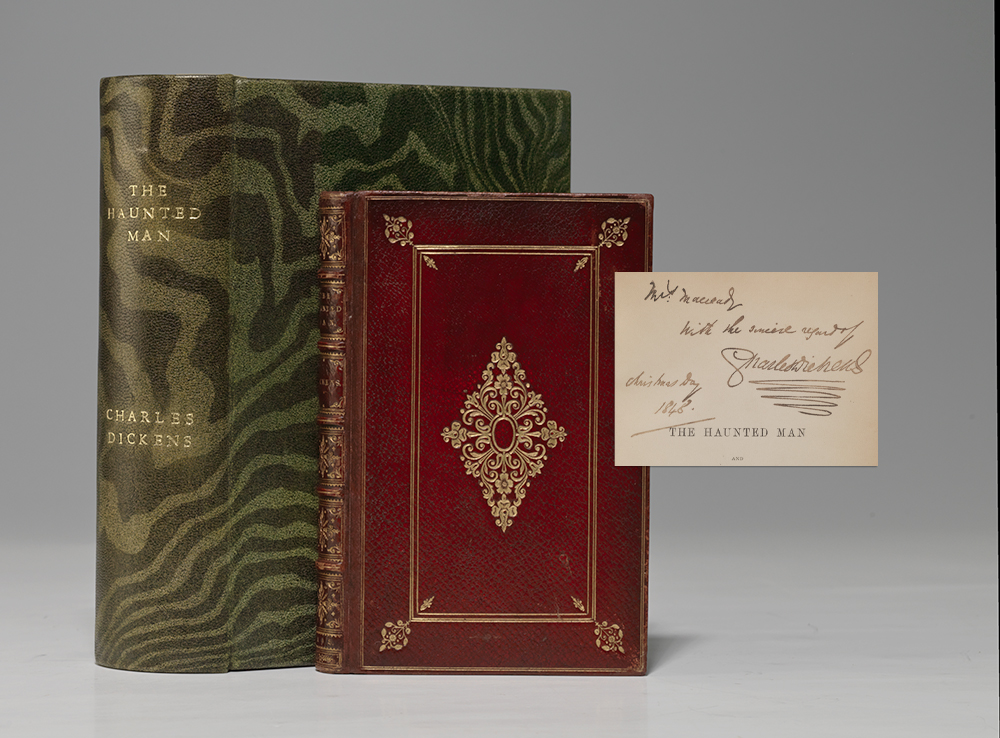Description
WARMLY PRESENTED AND INSCRIBED BY CHARLES DICKENS TO HIS CLOSE FRIEND MRS. CATHERINE MACREADY ON CHRISTMAS DAY: HIS LAST CHRISTMAS BOOK, THE HAUNTED MAN: “LORD, KEEP MY MEMORY GREEN”
DICKENS, Charles. The Haunted Man and the Ghost’s Bargain. London: Bradbury & Evans, 1848. 12mo, late 19th-century full crimson morocco-gilt, elaborately gilt-decorated spine, raised bands, all edges gilt, original cloth front cover bound in. Housed in a custom half morocco clamshell box.
First edition of Dickens’ last Christmas book, a very rare and desirable copy presented by Dickens to Mrs. Catherine Macready, the wife of “ the most famous Shakespearean actor of his day,” William Charles Macready; Macready and his wife Catherine were very close friends of Dickens and his wife. This is a Christmas Day presentation, which is rarely seen for Dickens, inscribed on the half title, “Mrs. Macready, with the sincere regard of Charles Dickens [flourish], Christmas Day, 1848.” Handsomely bound in full morocco-gilt by Riviere.
The recipient of this copy, Catherine Macready, along with her actor husband, William Charles Macready, were very close friends and part of Dickens’ inner circle. By the time Dickens met William Charles Macready, he was “already the most famous Shakespearean actor of his day, and someone for whom Dickens would have felt immediate respect and sympathy” (Ackroyd, Dickens, 210). Dickens dedicated Nicholas Nickleby to William Charles Macready, and in 1844, Dickens read his second Christmas book The Chimes in its entirety to Macready, an event he described in a letter to his wife Catherine: “If you had seen Macready last night—undisguisedly sobbing, and crying on the sofa, as I read—you would have felt (as I did) what a thing it is to have Power” (quoted in Ackroyd, 446).
Dickens and his wife Catherine and sister-in-law Georgina Hogarth were frequent guests at the Macready home and when Catherine accompanied Dickens to America in 1842, they entrusted the care of their children to Macready and his wife. Dickens spent two memorable Christmas holidays at the Macready residence; the first, at a Boxing Day party at Macready’s house in 1843, right after the successful publication of The Christmas Carol, when Dickens “broke out like a Madman” and with his friend John Forster “determined to give Mrs. Macready the best imaginable Christmas,” playing a conjuror and his assistant, and organizing numerous festivities. Later, Dickens wrote to her husband (who had been traveling during the party), “Mrs. Macready looked brilliant, blooming, young and handsome, and she danced a country dance with the writer hereof… for her gallant bearing always, and her best sort of best affection, is the best creature I know.” The second, on Dickens’ customary celebration of Twelfth Night in January of 1849, following the publication of his Haunted Man, Dickens “swept up Mrs. Macready into his arms: ‘For two mortal hours,’ he told her husband, they ‘danced without ceasing’” (Simon Callow). When Catherine Macready was dying in 1852, Charles Dickens visited her, and she was said to have cried out, too weak to rise, “Charles Dickens, I had almost embraced you—What a friend you have been!” After her death, Dickens wrote to her husband, “I have known her so well, have been so happy in her regard, and have been so light-hearted with her, have interchanged so many tender remembrances of her when you were far away… that I cannot write as I would, and as I know I ought.”
At the time Dickens began The Haunted Man, his last Christmas book, it was only a month since his sister Fanny had died of consumption. “The Haunted Man is concerned with the power of memory, with family life which is destroyed and replaced only by the wretched anxieties of a distinguished but solitary man; it is a story in which the central character’s mournfulness is linked closely with the death of a beloved sister. It is a strange and powerful book in which memories ‘come back to me in music, in the wind, in the dead stillness of the night, in the revolving years.’ The theme itself revolves around Dickens’ belief that memory is a softening and chastening power, that the recollection of old suffering and old wrongs can be used to touch the heart and elicit sympathy with the sufferings of others. In his autobiographical fragment he had written of his parents’ apparent neglect only to add that ‘I do not write resentfully or angrily, for I know how all of these things have worked together to make me what I am.’ Now, in the last words of this Christmas book he was writing, he put it another way: ‘Lord, keep my memory green…” With engraved frontispiece and additional title on toned grounds by Martin & Corbould after John Tenniel and 15 wood-engraved illustrations after Tenniel, Clarkson Stanfield, Frank Stone, and John Leech. Eckel, 121. Smith 9. Gimbel A119. Bookplate. Listed in the 1873 auction of the books of William Charles Macready, No. 66. Bookplate.
Interior clean. Expert repair to joints and restoration to extremities of morocco, gilt bright. An excellent copy of Dickens’ final Christmas book, most rare and desirable inscribed by Dickens as a Christmas present on Christmas day.



